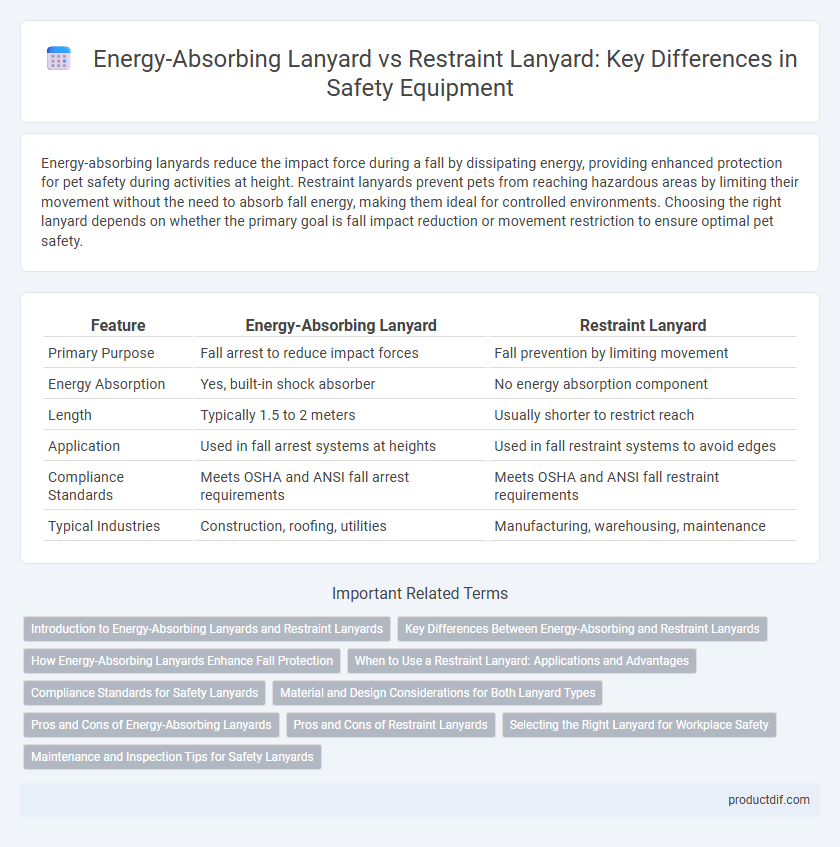Energy-absorbing lanyards reduce the impact force during a fall by dissipating energy, providing enhanced protection for pet safety during activities at height. Restraint lanyards prevent pets from reaching hazardous areas by limiting their movement without the need to absorb fall energy, making them ideal for controlled environments. Choosing the right lanyard depends on whether the primary goal is fall impact reduction or movement restriction to ensure optimal pet safety.
Table of Comparison
| Feature | Energy-Absorbing Lanyard | Restraint Lanyard |
|---|---|---|
| Primary Purpose | Fall arrest to reduce impact forces | Fall prevention by limiting movement |
| Energy Absorption | Yes, built-in shock absorber | No energy absorption component |
| Length | Typically 1.5 to 2 meters | Usually shorter to restrict reach |
| Application | Used in fall arrest systems at heights | Used in fall restraint systems to avoid edges |
| Compliance Standards | Meets OSHA and ANSI fall arrest requirements | Meets OSHA and ANSI fall restraint requirements |
| Typical Industries | Construction, roofing, utilities | Manufacturing, warehousing, maintenance |
Introduction to Energy-Absorbing Lanyards and Restraint Lanyards
Energy-absorbing lanyards are designed to reduce the impact force on a worker during a fall by extending and dissipating energy, thereby minimizing injury risk. Restraint lanyards prevent workers from reaching fall hazards by limiting their movement within a safe zone, effectively acting as a physical barrier. Both types of lanyards are essential components in fall protection systems, meeting OSHA and ANSI safety standards to enhance workplace safety.
Key Differences Between Energy-Absorbing and Restraint Lanyards
Energy-absorbing lanyards are designed to reduce fall arrest forces by extending and dissipating energy during a fall, making them essential for personal fall arrest systems. Restraint lanyards prevent workers from reaching fall hazards by limiting movement distance, effectively eliminating the possibility of a fall. The key difference lies in their primary function: energy-absorbing lanyards protect after a fall has occurred, while restraint lanyards prevent the fall altogether.
How Energy-Absorbing Lanyards Enhance Fall Protection
Energy-absorbing lanyards reduce the impact force exerted on a worker's body during a fall, significantly decreasing the risk of injury compared to restraint lanyards, which primarily prevent falls by limiting movement. These lanyards incorporate built-in shock absorbers that elongate under load, effectively dissipating energy and enhancing overall fall protection systems. Incorporating energy-absorbing lanyards in personal fall arrest equipment meets OSHA and ANSI safety standards, providing a critical safeguard for workers at height.
When to Use a Restraint Lanyard: Applications and Advantages
Restraint lanyards are essential in preventing workers from reaching fall hazards by limiting their movement within a safe zone, making them ideal for tasks near edges or openings where fall prevention is critical. These lanyards are commonly used in confined spaces, scaffoldings, and elevated work platforms, ensuring workers cannot access areas where falling could occur. Their primary advantage lies in enhancing workplace safety by physically restricting worker positioning, reducing the risk of fall incidents and compliance with OSHA regulations.
Compliance Standards for Safety Lanyards
Energy-absorbing lanyards comply with ANSI Z359.13 and OSHA 1926.502 standards, designed to reduce fall arrest forces during a fall event. Restraint lanyards adhere to OSHA 1910.140 and ANSI Z359.12, focusing on preventing workers from reaching fall hazards by limiting movement. Selecting lanyards compliant with these specific standards ensures optimal protection tailored to fall arrest or fall restraint applications.
Material and Design Considerations for Both Lanyard Types
Energy-absorbing lanyards utilize high-strength synthetic fibers combined with built-in shock absorbers designed to dissipate impact forces during falls, often incorporating tear-webbing or rope materials engineered for controlled elongation. Restraint lanyards predominantly feature durable, abrasion-resistant polyester or nylon webbing with fixed lengths, prioritizing minimal stretch to prevent workers from reaching fall hazards. Both types incorporate corrosion-resistant hardware, such as zinc-plated or stainless steel snap hooks and D-rings, engineered to maintain structural integrity under loading while meeting OSHA and ANSI safety standards.
Pros and Cons of Energy-Absorbing Lanyards
Energy-absorbing lanyards reduce impact forces on the body during a fall by dissipating energy, minimizing injury risks and providing greater protection in dynamic fall scenarios. They are ideal for situations where the possibility of a fall exists, but require regular inspection and replacement after a fall event to maintain effectiveness. These lanyards tend to be more expensive and bulkier than restraint lanyards, which can limit mobility and convenience in some work environments.
Pros and Cons of Restraint Lanyards
Restraint lanyards prevent workers from reaching fall hazards by restricting their movement, reducing the risk of falls entirely. They provide a straightforward safety solution with minimal repositioning needed during tasks, but their limited length can restrict mobility and hinder access to some work areas. Unlike energy-absorbing lanyards designed to arrest falls, restraint lanyards do not absorb impact forces, which eliminates the risk of fall arrest-related injuries but requires precise usage to ensure safety.
Selecting the Right Lanyard for Workplace Safety
Energy-absorbing lanyards reduce fall forces by dissipating energy during a fall, making them ideal for workplaces where fall arrest is a risk. Restraint lanyards prevent workers from reaching fall hazards by limiting movement, ensuring safety in environments with potential fall edges. Selecting the right lanyard depends on assessing fall hazards, work height, and whether fall arrest or fall prevention is required for optimal workplace safety.
Maintenance and Inspection Tips for Safety Lanyards
Energy-absorbing lanyards require thorough inspection for signs of wear, cuts, abrasions, and deformation, with emphasis on the energy absorber's condition to ensure proper shock absorption during a fall. Restraint lanyards demand regular checks for hardware integrity, secure stitching, and fabric degradation since they prevent reaching fall hazards rather than arresting a fall. Both types should be cleaned according to manufacturer guidelines, stored away from direct sunlight and chemicals, and retired immediately if any defect or impact damage is detected to maintain optimal safety performance.
energy-absorbing lanyard vs restraint lanyard Infographic

 productdif.com
productdif.com